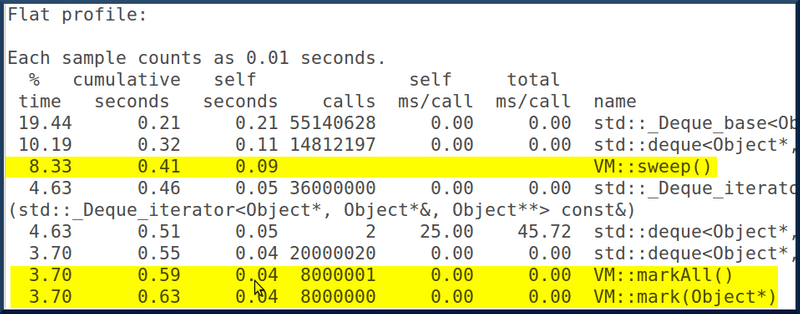The Big Oh of Optimization
2014-11-03We now have a functional GC, but we need to ask ourselves the question-Can we do better? This is a toy implementation, but if we look at something real, we find that the invocation of a mark-sweep GC causes pauses in the execution of the actual program, especially for programs which show a high memory utilization. When memory hits a low, the GC is invoked, and there are noticable pauses. Of course, we wouldn’t want these pauses to be too long so we need to figure out where we can do better.
What to Optimize
A good way to identify bottlenecks is by using a profiling tool like gprof. We add a new test for performance, where we initialize a heap of a 100,000 blocks and a threshold GC invocation of 1,000 blocks. The profiling shows the following results.

A lot of the execution time is spent in the standard library functions and in the core GC routines - mark & sweep. We now know what to optimize.
Optimizing the Mark Routine
Revisiting the mark routine, we see that it is recursive. There is a significant time and space cost associated with such a recursive function because of the slowness of function calls and returns, and the overhead of managing the stack. However, what recursion is great for is understanding the problem.
“Loops may achieve a performance gain for your program. Recursion may achieve a performance gain for your programmer”.
The algorithm is succinct and lends itself to easy interpretation - Mark an object if it isn't already marked; if it has references to other objects, mark those too.
void VM::mark(Object* object)
{
if(object->marked)
{
return;
}
object->marked = 1;
if(object->type == OBJ_PAIR)
{
mark(object->left);
mark(object->right);
}
}
Implementing Mark using an Explicit Stack
The mark routine can be implemented iteratively. We use an explicit stack for traversing allocated objects. It does the same thing, although the code is more contorted and unnatural.
As we traverse a node, it is marked; it is pushed onto the stack if there are other nodes reachable from it--if it is not an atom. The algorithm repeateadly pops elements from the stack, marks the elements reachable from the popped element and performs the same procedure till the stack becomes empty.
So, we've managed to convert the recursive algorithm into an iterative one, with some loss of elegance in the program code and some gain in speed.
Premature Optimization is the Root of All Evil
It’s a good idea to get a good grasp of the problem you’re trying to solve before trying to solve it better. Recursion helped us with just this--we understood what we were trying to do and then tried improving it.
While this code does improve our algorithm’s time, there is still the question of space. The size of the stack used for traversal grows linearly with the number of objects being traversed.
We ask ourselves the golden question-can we do better?
